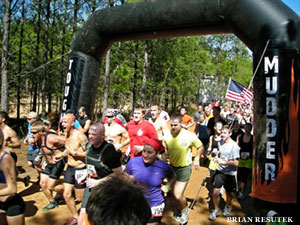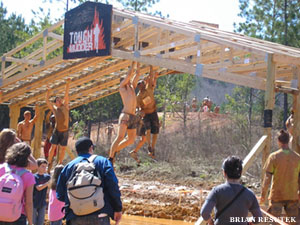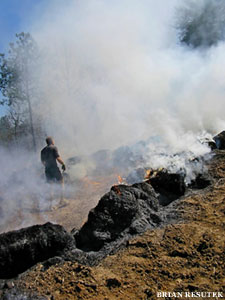The lead official for the race blasts out final instructions: “Go 150 meters straight ahead, and then you will make a hard left. The course is marked with red arrows. Go you Tough Mudders!”
I’m in the first wave of 3,800 runners. I’m stubborn, I hate to wait, and so that’s the only way I would enter this race. The lead runner ignores the instructions and heads straight. Everyone else chuckles and correctly head to the left. All are confident.
Then the turn ends and wham, the first five of us plunge chest high into freezing water.
The person who urged me to do this has a four-letter name; however, there were plenty of other four-letter words running through my head at that moment.
“Will you do this?”
Those were the words sent to me in an email with the website toughmudder.com in the email. I didn’t even need to click on the link as I’ve been sent it or similar multiple times over the years. I started to send the “No” response, but then five buddies chimed in. Well, the March 12 date did work, the distance seemed long enough, and I needed to quash this event once and for all.

The Tough Mudder is billed as “Ironman meets Burning Man.” It’s the longest and toughest of all the race-through-mud events, which appear to be growing in popularity. It was designed by a Harvard MBA with a background in counter-terrorism, so this is no pre-brunch jog along the Charles River. I’ve done the Ironman, in addition to several marathons, and I spent my undergraduate years at Michigan, running football practices as a team manager and watching future NFL Hall of Famers go through real training and pain. The last thing I wanted to do was surround myself with a bunch of stereotypical frat boys -- people still living the high school dream -- and check a box so I could brag to the co-workers on Monday about my “experience.” I love to compete and race hard, but I also still pay the entry fee like everyone else. If I was seriously any good, I wouldn’t have to.
It’s 9:05 a.m. in Highland Park, a motor-cross terrain area about 90 minutes west of Atlanta. At least I think it’s 9:05 a.m. Like any runner, I want to know my time; however, my watch is caked in mud after the sudden bath and it’s useless to try to clean it off. I have my race number tattooed on my head, yes, my forehead, but I’m sure it is visible to no one right now. I will lose my paper race number in another mile or so. The air temperature is 38 degrees, the water is maybe slightly warmer. I’m drenched in cold mud and water and trying to catch my breath. Come on, seriously: This is a 12-plus mile obstacle course race, and I’m less than a mile in.
The advantage of going early in the day, which I insisted on doing, is that there are no other groups ahead of you -- provided you get out in front of the pack yourself. In reading blogs during the past two months, this was the biggest complaint of this race series. So I submitted a request for an elite start time, based on my marathon finishes, and that put me in Wave 1 with a bunch of other type-A hammerheads.
Crawling alone through some narrow tubes filled with mud, and then under some 8-inch barbed-wire, goes fairly well outside of some scraping of the knees. My running shoes are covered in the famous Georgia clay-like substance, and the shorts and shirt match rather nicely I suspect.
I’ve just gained about five additional pounds in 10 minutes of racing. After splashing through yet another waist-high, 200-foot long mud pool, swimming optional, we hit a hilly motor-cross track, and the group starts to grow smaller as people thin out and the running starts to build.
In the distance, I can hear the race organizer giving the Tougher Mudder oath to the next wave and telling them stories of true heroes competing in the race and how stupid we all are to be here today. Passion. Yes, this organizer clearly had it. The sun starts to make its way out, and course creators steer us away from the water obstacles and into the hills of Western Georgia. While the day is almost perfect for running, heavy rain earlier in the week has made the trails nice and muddy -– as if by design.
My first thought heading into the woods is that I don’t want to get lost or hurt. I know how to trail run, but a wrong turn with my stubbornness would lead me into Alabama before turning around. Fortunately, the course is surprisingly well-marked. It’s up and down some hills for about two miles and I’ve found my running groove. I look around and there is no one except two or three guys behind me. I’m winning.

A bad stumble on one of these rocks, however, and you are most likely going to be there a while seeking medical attention. I should add that you are constantly reminded throughout the race by signs stating you signed your death certificate waiver and the Tough Mudder is watching you.
I’m nearly dry as I see the Mile 5 sign, and cross a small bridge in the woods. Straight up the hill, the arrows point. Seriously? Cardiac and Heartbreak Hill are child’s play compared to this deal. I do a combination of running and crawling on all fours to the top, where I find the trail head and arrows pointing me almost straight back down the hill. I run down using trees to slow my speed. I pray I don’t bite it as my legs are shot.
After completing yet another, less steep climb to the top, I’m greeted with, “Congrats, pick a log and carry it with you around this quarter-mile loop”. All the logs are six-to-eight feet long and about 12 inches in diameter. I snag what looks like a small, seven-footer and plug along the loop thinking -- while this sucks -- this particular obstacle is pretty well thought-out. I carry/run Rocky IV style as if I’m in Russia training for Drago. Minus the snow, of course.
Making it out of the woods at about Mile 9, I find water station No. 3. No Gatorade or gel stops at this event. I pound a cup. You can’t skip these water stops like in traditional races. In 500 yards lay four, 12-foot “Berlin Walls” and you must scale two of them. I feel my legs cramp as I spring up the first. This is what those company-bonding ropes courses should have instead of the lame trust falls and spider webs.
I now find myself in front of a fairly large group of spectators. This obstacle is called the “Funky Monkey” and is a well-designed monkey bar built on a wood frame truss that is suspended over (you guessed it) a pool of water and mud of unknown depth. My ego is boosted by the encouragement, but soon classic one-liners like, “Your shoes are untied!” “Your pants are falling down!” and “My 5-year old is better than you!” rain down to cancel the positive sentiments. I make the traverse cleanly and scamper across a mud pit to a balance beam stationed half-mile away that wobbles under me as I try to calm my gassed legs. I tiptoe across and then sprint the last 15 feet like on the old episodes of “Double Dare.”
I’m still in the lead.
There are about two miles left in the race, supposedly. The organizers don’t know the full distance, they say. It is longer than they had planned for and they “apologize.” Their GPS quit working after 12 miles, we were told at the start. Great.

“Fire-Walker” is next, and it is a smoky maze of burning hay bales where competitors try to hustle through the smoke and avoid running into the fire. It’s similar to an earlier obstacle called “Smokehouse.” No one has ever burned, I’m told, outside of a participant who ran the whole race in a Shrek costume and became disoriented by his mask. I leave this maze feeling like I just took in a full Marlboro Red for the second time this morning.
My eyes clear of the smoke and I realize I’m getting passed. I’m disappointed. But the new leader tells me to finish strong and I return the same wish. Life will go on tomorrow. I think.
After the leaving the fire maze, it’s time for the final stretch of this crazy, um, challenge. This involves doubling back on the first part of the course again. Here I encounter participants at the beginning of their challenge. My mind is playing games with me, and I wonder if I have made a wrong turn. The motor-cross hills are even harder the second time, and getting through the cargo net obstacles and barbed-wire comes slowly.
I see countless people on their first mile or two, walking, gasping, and stopping. I think, “How are you ever going to finish this deal if you are already feeling like that?” (I'd find out later only 71 percent of those who began this event would finish it.) But not everyone is gunning for Boston or Kona, which is a large reason why these events can appeal to all levels and/or goals – everyone pays an entry fee and the more people challenge themselves, the more these events can take place. Having personally accomplished a physical goal that I never thought possible – when I completed my first marathon -- I know it’s pretty special. And not always about the finish time. I give some encouragement to those in early race stages and attempt to catch the leader, but he slowly creeps away.
Finally, after tackling some more muddy slop and one more 12-foot Berlin Wall, I’m told I’m nearing the finish area. As I run through a chute towards the last two obstacles, I slap hands with a guy running the other way who I recognize back from the race start. Then I climb a ramp to find myself on top of a 20-foot platform over a pond of freezing water. Oh boy.
Someone yells out, “Cannonball!” I flashback to July 4th memories of jumping off a rope swing 35 to 40 feet high with some good friends in Lake Lanier. I think of jumping off cypress trees in Blue Hole with my brother, outside of Austin, Texas.
Then I jump.
My body goes numb as I’m submerged in the water deeper than I expected. After two strokes up, I’m still underwater. I mildly panic.
After what seems like forever, I surface and breathe. I swim with my head up, going nowhere fast, for 60 yards to shore as people yell for me to get out. I’m almost there, but …

My foot gets stuck in the mud. I’m tired and disoriented, and did I mention the water temperature! I make it to shore, and yes, there is one last obstacle. It is clearly for the spectators: a gauntlet of live wires that carry 10,000 volts of shock. I run through and get jolted bad twice as the crowd ohhs and ahhs. I’m knocked back a bit, but relieved when there are no more wires in front of me. Was that good for my long-term health?
I couldn’t care less right now.
I cross the finish line, disoriented.
“Congrats man! Second place,” the nice volunteer says to me as I hunch over and grab my knees. Another volunteer approaches to hand me water as I zigzag towards him and realize that I am still kind of dazed. I’m given an orange “Tough Mudder” head band in lieu of the second-place medal and pick up my T-shirt. I exchange congratulations with the first place guy and realize that it’s over. No need for a ceremony or timing chip return or checking to see the “final results” because there really are none. While there is a race element to Tough Mudder, it’s mainly a challenge. And even as someone who likes to see my rank in the final rundown, I find no real fault in this.
As I watch my fellow comrades finish, I’m informed I can attend the World Championship of Tougher Mudders in December. Place undecided. Distance undecided. I'm told to "expect 50 miles of mud, ice, snow, fire, hot coals, rock climbs, barbed wire, electric fencing, underwater swimming, boulder carries, rope climbs, extreme weather conditions and 100-foot dives from waterfalls."
Only 10 percent are expected to finish.
I might choose not to open the next email from my four-letter friend.




